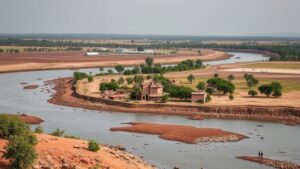Navigating the Tigris and Euphrates rivers to trace the remains of Sumerian cities long lost to shifting waterways.
Navigating the Tigris and Euphrates Rivers: Tracing the Remains of Sumerian Cities
The Tigris and Euphrates rivers, often lauded as the lifeblood of ancient Mesopotamia, are not only geographical landmarks but also conduits to explore one of the cradles of civilization–Sumer. Today, navigating these waterways offers not just a journey through scenic landscapes but also a poignant look into the remains of cities that once thrived in this fertile region, now long lost to shifting waterways.
The Significance of the Tigris and Euphrates Rivers
The Tigris and Euphrates rivers flow parallel to each other, stretching across modern-day Iraq. Together, they form a vital basin that supported the rise of Sumerian civilization around 4500 BCE. rivers were vital for agriculture, trade, and transportation, crucially shaping the socio-economic structure of the cities that emerged along their banks.
As a geographical reference point, the Euphrates runs approximately 2,800 kilometers (1,740 miles), while the Tigris is slightly shorter at about 1,850 kilometers (1,150 miles). These rivers provided not just fresh water but also fertile soil through annual flooding, enabling the advancement of agriculture which ultimately led to urban development.
Shifting Waterways: The Impact on Sumerian Cities
Over millennia, the courses of these rivers have shifted, leading to the rise and fall of several Sumerian cities. Key ancient sites such as Ur, Eridu, and Babylon are now located far from their original banks. For example, the city of Ur, founded around 3800 BCE, was initially situated nearer to the Euphrates. Today, it sits nearly 16 kilometers (10 miles) from the river’s modern course.
This movement of waterways has often rendered archaeological sites inaccessible over time. Sediment deposition, shifts in tectonic plates, and climate change have transformed the physical landscape, posing challenges to historians and archaeologists studying this area.
Key Archaeological Sites Along the Rivers
Several key archaeological sites along the Tigris and Euphrates rivers serve as a testimony to Sumerian civilization:
- Ur: Known for its impressive ziggurat and as the birthplace of Abraham, Ur was one of the leading cities in ancient Sumer. Excavations began in the 1920s, revealing a wealth of artifacts.
- Eridu: Considered by some to be the oldest city in the world, Eridu holds significance for its temples dedicated to the water god, Enki. Its ruins offer insights into early urban planning and religion.
- Babylon: The legendary city known for its Hanging Gardens, Babylon was located near the Euphrates. Its remains, including the Ishtar Gate, reflect the grandeur of later Mesopotamian architecture.
The Journey: Navigating the Rivers Today
Today, navigating the Tigris and Euphrates by boat can provide unique access to sites that are otherwise not easily reachable. River navigation not only enhances the travel experience but also offers a tangible connection to the past. Several tour operators provide guided riverboat tours that combine both the scenic beauty of the rivers and archaeological exploration.
For example, a journey on the Euphrates might include stops at historical sites while also showcasing the stark beauty of the surrounding landscapes. Exploring the rivers’ banks reveals remnants of ancient settlements sometimes just a few steps from the water.
Challenges and Considerations
While the prospect of tracing forgotten Sumerian cities along the Tigris and Euphrates is enticing, travelers must also be mindful of several challenges:
- Environmental Changes: Climate change has altered river flows and sedimentation patterns. Understanding these shifts is critical for navigating both safely and effectively.
- Political Stability: Some regions along these rivers may be politically sensitive. It is essential to stay informed about the current security situation.
- Preservation Efforts: The remains of these cities are often buried beneath layers of sediment or endangered by modern development. Supporting local archaeological efforts can help preserve these historical sites.
Actionable Takeaways
As you consider a journey along the Tigris and Euphrates, keep these actionable insights in mind:
- Research local tour operators that specialize in historical and archaeological experiences.
- Engage with local archaeologists or historical societies to better understand the context and importance of the sites.
- Stay updated on environmental and political situations to ensure a safe and enjoyable expedition.
Navigating the Tigris and Euphrates rivers offers not only an adventure through breathtaking landscapes but also a profound connection to the ancient Sumerian civilizations that once flourished along their banks. As you embark on this journey, remember that each bend in the river is a testament to human history and resilience.



